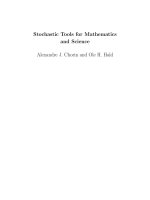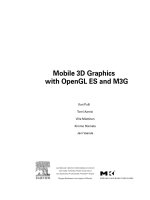3D printing basic concepts mathematics and technologies
Bạn đang xem bản rút gọn của tài liệu. Xem và tải ngay bản đầy đủ của tài liệu tại đây (361.55 KB, 4 trang )
3D Printing: Basic concepts Mathematics and Technologies
Athanasios Anastasiou, Charalambos Tsirmpas, Alexandros Rompas, Kostas Giokas, Dimitris
Koutsouris
School of Electrical and Computer Engineering National Technical University of Athens, Biomedical
Engineering Laboratory, Athens, Greece
Abstract: 3D printing is the process of being able to print
any object layer by layer. But if we question this proposition,
can we find any three dimensional objects that can't be
printed layer by layer? To banish any disbeliefs we walked
together through the mathematics that prove 3d printing is
feasible for any real life object. 3d printers create three
dimensional objects by building them up layer by layer. The
current generation of 3d printers typically requires input
from a CAD program in the form of an STL file, which
defines a shape by a list of triangle vertices. The vast majority
of 3d printers use two techniques, FDM (Fused Deposition
Modelling) and PBP (Powder Binder Printing). One advanced
form of 3d printing that has been an area of increasing
scientific interest the recent years is bioprinting. Cell printers
utilizing techniques similar to FDM were developed for
bioprinting. These printers give us the ability to place cells in
positions that mimic their respective positions in organs.
Finally through series of case studies we show that 3d printers
in medicine have made a massive breakthrough lately.
I.
INTRODUCTION
3d printing is a rapidly developing technology in the last
years. This industrial revolution has applications in the fields
of engineering, medicine and many more. These include
creation of mass-customized products, prototypes,
replacement parts and even medical and dental implants.
The speed and ease of designing and modifying products has
made them the number one rapid prototyping technique. The
aim of this article is to evaluate this matter from another
point of view by focusing on their contribution to the fields
of medicine. We will first examine the mathematical
knowledge behind 3d printing through the opinion of
experts. Next we will give a short description of the most
famous 3d printing methods highlighting one special form,
bioprinting. Finally we will focus on a series of case studies
where 3d printers where used to guide surgeons, create
Manuscript received July 26, 2013. This work was supported by
Biomedical Engineering Laboratory of the National Technical University of
Athens.
Athanasios Anastasiou is with the National Technical University of
Athens, in the Biomedical Engineering Laboratory, Athens, Greece (email:).
Charalambos Tsirmpas is with the National Technical University of
Athens, in the Biomedical Engineering Laboratory, Athens, Greece (email:).
Alexandros Rompas is with the National Technical University of Athens,
in the Biomedical Engineering Laboratory, Athens, Greece (corresponding
author, e-mail:).
Kostas Giokas is with the National Technical University of Athens, in
the Biomedical Engineering Laboratory, Athens, Greece (email:).
Dimitris Koutsouris is with the National Technical University of Athens,
in the Biomedical Engineering Laboratory, Athens, Greece (email:).
978-1-4799-3163-7/13/$31.00 ©2013 IEEE
enhanced human parts and mend human skull defects.
II. 3D PRINTING MADE REAL: FUBINI THEOREM
Before we turn our focus on printing a three-dimensional
model we have to consider what mathematical statements
and theorems allow us to materialize this idea. Practically 3d
printing is about being able to print any object layer by
layer. But if we question this belief, can we find any threedimensional objects that can't be printed layer by layer?
So next we will analyse the theorem that proves 3d printers
can duplicate everything (any real life physical object at
least). Fubini's theorem, named after the Italian
mathematician Guido Fubini, states that an object of n
dimensions can be represented as a spectrum of layers of
shapes of n-1 dimensional layers. This means that a 3
dimensional shape (any shape in the real world) can be
portrayed as layers of 2 dimensional shapes [1]. In 3d
printing technology this means that we are able to express
any 3d object as layers of 2d planes. Below we provide the
theorem but not its proof since doesn’t serve the purpose of
this article. [2]
In order to analyse the theorem, we Suppose A and B are
complete measure spaces. Supposes f(x,y) is A x B
measurable. If
(1)
Where the integrals is taken with respect to a product
measure on the space over A x B, then
(2)
The first two integrals being iterated integrals
with respect to two measures, respectively and the third
being an integral with respect to a product of these two
measures.
If the above integral of the absolute value is not finite, then
the two iterated integrals may actually have different values.
Thus we have that:
Fi f(x,y)=g(x)h(y) for some functions g and h, then
(3)
The integral on the right side being with respect to a product
measure.
Fubini’s theorem proves that 3d printers can print any real
life objects. However, a practical limitation is the slicing
resolution and also the achievement of physical stability
during layering [1].
III. FUSED-DEPOSITION-MODELLING
FDM 3d printers operate by building layers via the extrusion
of thin semi molten plastic beads, usually ABS
(Acrylonitrile Butadiene Styrene) plastic. This material is
quite attractive for its properties since it has low toxicity
levels, is highly durable and hard. It can be dyed with
different colours nevertheless ABS is typically used in its
natural off-white form. One of its disadvantages is that it
comes out soft thus any overhanging parts need to be
supported with the appropriate structures until it hardens [2].
FDM printers are known for their ability to print strong and
precise objects that can be used for many applications. The
process described, is shown in Figure 1 below.
structures can be printed with cells representing biological
ink. According to the above, successive layers could be
produced just by dropping another layer of gel onto an
already printed surface.
Figure 1. Fused deposition modeling: 1 - nozzle ejecting molten plastic, 2 deposited material (modeled part), 3 - controlled movable table
Figure 2. Principle of organ printing [3]
IV. POWDER -BINDER PRINTING
This technique works by building up layers of a plaster-like
powder that is sprayed by a liquid binder, or glue from an
ink-jet printer head. In every pass a new layer of loose
powder followed by the binder spray is applied [2]. In order
to understand these processes we can visualize each layer of
powder as a piece of paper. Having said that this technique
doesn't differ significantly from conventional 2d ink-jet
printing except that each layer fuses with the previous ones.
Any remaining powder not sprayed with binder is removed
to be recycled for further use after the end of the process.
One of the greater advantages of this method is that the
powder can hold all every overhanging part of the structure
in place, so no supports are needed. However, it may be
required that some parts of the printed object still need
support in case they are long overhanging or too thin [7].
V. BIOPRINTING
An alternative type of 3d printing with increasing academic
interest is bioprinting. Bioprinting, as described in the
International Conference of Bioprinting and Biofabrication
in Bordeaux, is ”the use of computer-aided transfer
processes for patterning and assembling living and nonliving materials with a prescribed 2D or 3D organization in
order to produce bio-engineered structures serving in
regenerative medicine, pharmacokinetic and basic cell
biology studies” [4]. For bioprinting purposes, cell printers
utilizing similar techniques to FDM were developed. These
printers give us the ability to place cells in areas that mimic
their respective coordinates in organs. The capability to drop
cells on previously printed successive layers provides an
opportunity for three dimensional organ printing [3]. Such
breakthrough of bioprinting technology in three dimensions
draws from the use of thermo-reversible gels. Gels are fluid
at 20oC and above 32oC and therefore similar to
conventional printing methods can be applied, so as tissue
This technology allows us to print 3D complex organs with
accurate and precise assignment of various cell types to the
gel. Feasibility of this technology can be shown, if we take
into consideration that human cells are placed close enough
in sequential layers of 3d gels, which can be fused and
create fully functional organs and cultured in vitro. The
process is illustrated in Figures 3 and 4 below.
Figure 3.The Mathematical model of cell aggregate behavior when
implanted in a 3D model gel [8].
Figure 4. Tissue self-assembly after the careful placement of cells in the
original geometrical positions [8].
This principle of cell self-assembly into fully vascularized
tissues is similar to the way embryonic like-issues sort and
fuse into functional forms dictated by the rules of
developmental biology. Another approach to the creation of
living tissues and organs through bioprinting is based on
mathematical modelling using a set of theoretical principles,
rules or laws related to spatial organization [11]. While this
idea appears promising, some issues were raised by the
Global Medical Society with regard to cell survival, tissue
perfusion and vascularization. Material issues are of utmost
importance as well since they can enhance the whole process
but also negatively influence cell fate [3], [8].
VI. CASE STUDY AND SCENARIO
Taking into account an efficient surgical plan, information is
extracted via CT and MR images. These images provide
doctors with sufficient information regarding the patient’s
anatomical structure. Followed by the analysis of twodimensional images, surgeons can generate a more careful
intraoperative procedure. The understanding internal and
external structure of organs could potentially be magnified,
if doctors have in hand a real three-dimensional object
illustration instead of a virtual one. Innovative technologies
such as prototyping can produce different methods of organ
replication based on patient-specific data. Therefore, if the
procedure is meticulous and successful the result precisely
illustrates the defection of the organ under examination.
Below, we describe the steps followed for the creation of a
human heart showing a congenital defect.
Prior to implementation, a visual three-dimensional
representation of heart must be plotted in a computer. Thus,
the data extracted from CT or MRI images are processed in
order to obtain a three-dimensional model depicting the
desired structures. All the above require a deep
understanding in the field of digital image processing
(segmentation, region growing, smoothing) resulting a
VRML (Virtual Reality Markup Language) file which is
imported in 3D printer as input so the desired object can be
produced.
Figure 5. Workflow network of processing the image data to obtain a 3D
model suitable for the RP process. The result of the segmentation is
improved by applying local segmentation processes with adjusted threshold
values. After the surface has been generated, the data are exported to
VRML data format [7].
More precisely, the VRML file containing the virtual
representation of the three dimensional model is loaded into
the controlling system of the 3D printer. The 3D printer
produces the model from starch by slices, each having a
height of 0.2mm. Each slice is rolled out to the building area
fetching the powder from the feed tray. Once, the resulting
model is in position the powder is fixed by a binder with the
use of inkjet technology. In the same fashion as common
printers, all colours can be produced in inkjet printers by
mixing cyan, magenta and yellow binder.
Vascular structures have a great risk of breaking or falling
apart during the manufacturing process if the stability of the
object is not guaranteed. During the printing the model is
surrounded with loose powder. The amount of binder
sprayed onto the powder is reduced within the interior of the
model, so that the model’s weight is decreased but its
surface is kept solid. Following this process our structure is
protected from having its sensitive parts cracked, broken or
deformed. When the last layer is applied and construction is
completed, our 3d prototype is left to dry for approximately
60 minutes. Subsequently, any loose powder surrounding
our model is removed with the use of an air jet. Before
proceeding any further our printed model is left to dry for 46 hours depending on its size at 70o C.
In order to achieve the required stability while avoiding
having a stiff 3D model we filter an elastomer based on
polyurethane allowing for high flexibility characteristics.
Additional layers of elastomer will follow, in order to
stabilize and smoothen the model without reducing its
flexibility. Finally, the parts of prototype are bent. The
remaining starch in the interior breaks and can be removed
giving us the final printed-model consisting only from
elastomer. To remove the remaining starch we have to flush
it out. For that reason, a hole is drilled into the surface of the
3D model with a diameter of at least 1mm. Next the printed
model is left in a vessel full of water for 6 hours allowing
the starch to be resolved into the water and flushed out. The
final result is showed in the image below [7].
Figure 6. A beating heart model [7].
It is worth mentioning that the resulting printed-model
described above is patient-specific. Therefore, if we account
for a new patient, the whole procedure must be followed
from scratch in order to include the unique anatomical
characteristics.
Compared to a two-dimensional printed object, in 3D
representations dimensions and distances among structures
can be conveniently examined. Moreover, the 3D printing
technique used offers resolution less than 0.01 mm in
horizontal directions and about 0.2 mm in vertical directions
[7]. This gives us the opportunity to reconstruct all
anatomical details as the resolution provided conforms to
the original image. Therefore, the doctor can carefully
construct an optimal strategy for a successful surgery,
foresee any possible complications and plan in advance how
to cope with them.
In our example the heart model produced showed a
congenital defect as shown in the image below.
Figure 7. Manufactured model showing a congenital defect. The left
subclavian artery (arrow) is abnormally connected to the right descending
aorta. This defect is clearly identifiable at the reconstructed 3D model [7].
Apart from denoting any defects of the real organ, the 3D
printing object could not possibly serve any other purpose
such as organ transplantation.
VII. CONCLUSION
The contribution of 3d printers in the field of medicine is
ground-breaking. With the use of powder printing surgeons
are able to assemble three- dimensional heart printed-models
from patient-specific data and define the optimal pathway,
with regard to cardiac defects under examination. Through
the use of bioprinting and syringe extrusion techniques we
were able to develop functionally enhanced bionic ears.
Moreover, applying powder based printing techniques
implants to mend cranial and maxillofacial lesions is a
possibility. Whereas, production of inorganic materials like
elastomeric hearts or cranial implants is much easier, live
organ printing such as a bionic ear capable of being used for
implantation in vivo to a human, has been proved to be
feasible yet it needs further investigation. In years to come
scientists ought to work towards any implementation issues
and eliminate critical technological barriers. So forth, it is
not arbitrary to predict that in the foreseeable future 3D
printing and bioprinting will be used as biomedical research
tools as the electron microscope in the 20th century.
REFERENCES
[1]
Ide, A.(2012)the mathematics-of-3d-printing.Retrieved Oktober
16,2013, from />[2] Berman, A. “3-D Printing Making the Virtual Real.”EDUCAUSE
Evolving TechnologiesCommittee. 2007. Web.1 May 2010.
[3] Boland, T., Mironov, V., Gutowska, A., Roth, E. A., & Markwald,
R. R. (2003). Cell and organ printing 2: fusion of cell aggregates in
three-dimensional gels. [Research Support, U S Gov't, Non-P H S].
Anat Rec A Discov Mol Cell Evol Biol, 272(2), pp. 497-502.
[4] Guillemot, F., Mironov, V., & Nakamura, M. Bioprinting is coming
of age: Report from the International Conference on Bioprinting and
Biofabrication in Bordeaux (3B'09): Biofabrication. 2010
Mar;2(1):010201.doi: 10.1088/1758-5082/2/1/010201. Epub 2010
Mar 11.
[5] Klammert, U., Gbureck, U., Vorndran, E., Rodiger, J., MeyerMarcotty, P., & Kubler, A. C. (2010). 3D powder printed calcium
phosphate implants for reconstruction of cranial and maxillofacial
defects. [Research Support, Non-U S Gov't]. J Craniomaxillofac
Surg, 38(8), pp. 565-570.
[6] Mannoor, M. S., Jiang, Z., James, T., Kong, Y. L., Malatesta, K. A.,
Soboyejo, W. O., Verma, N., Gracias, D. H., & McAlpine, M. C.
(2013). 3D Printed Bionic Ears. Nano Letters.
[7] Markert, M., Weber, S., & Lueth, T. C. (2007). A beating heart
model 3D printed from specific patient data. Conf Proc IEEE Eng
Med Biol Soc, 5, pp. 4472-4475.
[8] Mironov, V., Boland, T., Trusk, T., Forgacs, G., & Markwald, R. R.
(2003). Organ printing: computer-aided jet-based 3D tissue
engineering. [Research Support, U S Gov't, Non-P H S]. Trends
Biotechnol, 21(4), pp. 157-161.
[9] Tsirelson, A. (2011). Analysis 3 Lecture Notes Fubini theorem
Available: />[10] Zakeri, S. (2007). Math 208 note1 Available:
/>









![webgl beginner's guide [electronic resource] become a master of 3d web programming in webgl and javascript](https://media.store123doc.com/images/document/14/y/iu/medium_iud1401384400.jpg)